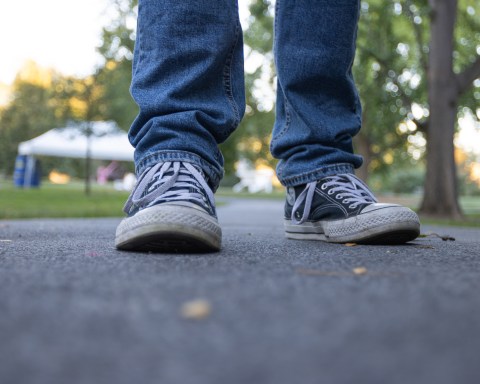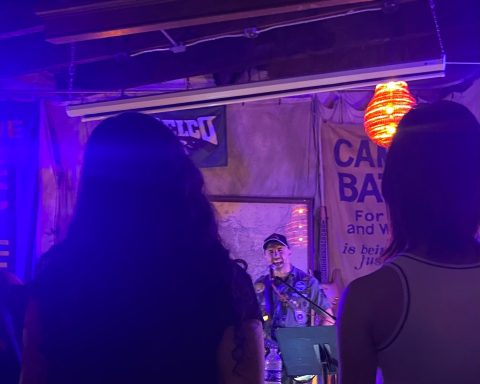Editor’s note: This article was initially published in The Daily Gazette, Swarthmore’s online, daily newspaper founded in Fall 1996. As of Fall 2018, the DG has merged with The Phoenix. See the about page to read more about the DG.
 In “Arsenic and Water,” a photograph in J. Henry Fair’s current exhibit in McCabe, a river of red seems to flow between two ashy mountains. This crimson scarf, blanketing the landscape, looks sanguine and insidious. What appears to be a beautiful watercolor or oil painting is in fact the slurry runoff from a coal-fired electric plant.
In “Arsenic and Water,” a photograph in J. Henry Fair’s current exhibit in McCabe, a river of red seems to flow between two ashy mountains. This crimson scarf, blanketing the landscape, looks sanguine and insidious. What appears to be a beautiful watercolor or oil painting is in fact the slurry runoff from a coal-fired electric plant.
The exhibit, entitled “Extraction and the American Dream,” contains visually striking images of hydraulic fracturing operations, mineral extraction facilities, and the BP Gulf of Mexico oil spill. Fair’s aerial photographs of formerly pristine natural landscapes, marred by the extractive industries, are often so large in scale that they seem abstract. They are visually exquisite, despite their depictions of natural destruction.
Last Thursday and Friday afternoons, Swarthmore students, faculty and community members had the opportunity to meet the artist and environmental activist J. Henry Fair.
During his brief lecture and Q & A session on Friday, Fair discussed everything from his political views to his artistic ventures in a colorful, often irreverent manner.
“I use renaissance styles to create abstract art […] to create images that make people stop to ask questions” Fair said. “I’m raising the question, are we citizens or are we consumers?” This question remained central throughout his speech.
After asking the audience whether they liked the cable TV channel Animal Planet and seeing many raised hands, Fair said, “we get our inspiration from animals and then we run to the refrigerator and pull out a hamburger and paper towel. We don’t think about how much damage we are doing to natural systems […] That’s ultimately what I’m taking pictures about […] I’m trying to tell a story about the environment, about our consumerism, our addiction to petroleum.”
Fair also articulated this message in a discussion with members of Swarthmore’s Ecosphere, mostly attended by members of Mountain Justice (MJ). Fair described his work as telling the stories of people on the frontlines. “I’d like to tell the whole story cradle to grave,” he said. “That story is how these people are affected by these industries.”
When asked what he felt the take-away message from his exhibit should be for Swarthmore students, Fair said, “everything we buy has a consequence, especially for young people. You will have to pay for these hidden costs.”
Fair’s work is intended to expose some of the effects of long chains of consumption, he said at Thursday’s discussion. By flying over sites of environmental degradation, he exposes that which is often hidden from the public eye. Though his primary interests are photography and environmentalism, Fair said he was “also fascinated by […] icons of any society in decay, especially industrial iconography.”
He also spoke with the group about MJ’s current divestment campaign. Fair stated that he “highly agree[d]” with the movement and that, if successful, the campaign would be a “striking blow against the empire, a small economic sting. The political, the statement value is substantial.” Fair encouraged MJ to approach negotiations with the Board of Managers with solutions or alternative investments.
Fair also spoke to his own personal scruples with the work he does during Thursday’s discussion. Sara Blazevic ’15, who attended the meeting, asked Fair how he reconciled his work’s message with the means of making such work, highlighting the carbon footprint of planes and photography. “I hate it,” he said. He said he hoped his artwork’s message was making a difference, but regretted his frequent use of airplanes.
In response to a question from Kate Aronoff ’14 at Thursday’s discussion, Fair said that although reactions to his artwork vary, his message comes through in the photographs regardless of opinion on his lectures or conversations. “Art does sidestep the dialectic freeze-up,” he said.
Audience members at Friday’s lecture were particularly taken by the strength of Fair’s images.
“The horror and the beauty [of the photographs] are magnificent,” said Pamela Harris, Outreach and Instruction Librarian at McCabe, who was involved with the exhibit’s planning and installation. “What’s so great about this show is that everyone who would walk in [to the library] would stop,” she continued. “This exhibit speaks to Swarthmore’s curriculum and its extracurricular activities.”
While many members of the audience attended with the hope of learning about Fair’s environmental activism and political views, some particularly appreciated the photographs for their artistic merit. “The colors on a plane were really well constructed,” said Shaina Lu ’16, a student interested in pursuing studio art. “You could see that it was an oil spill but the contrast of colors and organic forms still made it a work of art.”
Fair’s exhibit and lectures came to Swarthmore via a 2010 class project in an Environmental Studies capstone seminar regarding water rights.
Carol Nackenoff, the Richter Professor of Political Science who taught the seminar that year, explained saying, “Students wanted to create [a website] about hydrofracking on the Marcellus Shale and a student found [Fair’s] photographs. We negotiated permission to use some of these photos for the website.”
The funding was made available through the Tri-Co Creative Residencies Program, supported by the Andrew W. Mellon Foundation. “Fair’s agent mentioned that he was interested in having shows or residencies at academic institutions,” Nackenoff said. “When we learned about the Mellon [grant] money, I immediately started suggesting the possibility [of Fair], put in a proposal, got funding.”
For her own part, Nackenoff enjoyed the exhibit and the visibility it brings to issues relating to environmental degradation. “I found [the photos] arresting,” she said. ”He’s figured out a way to reach a really wide audience.”
Fair will return to Swarthmore’s campus between February 15 and 18 to give lectures and speak to students. He said the lectures would likely be focused around a local issue.















